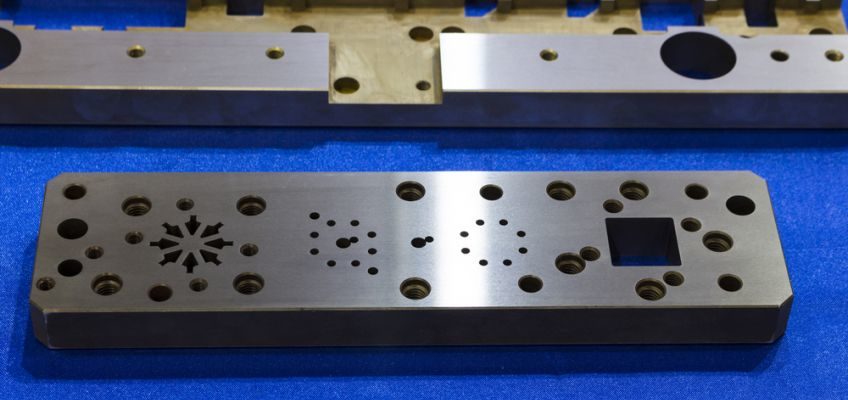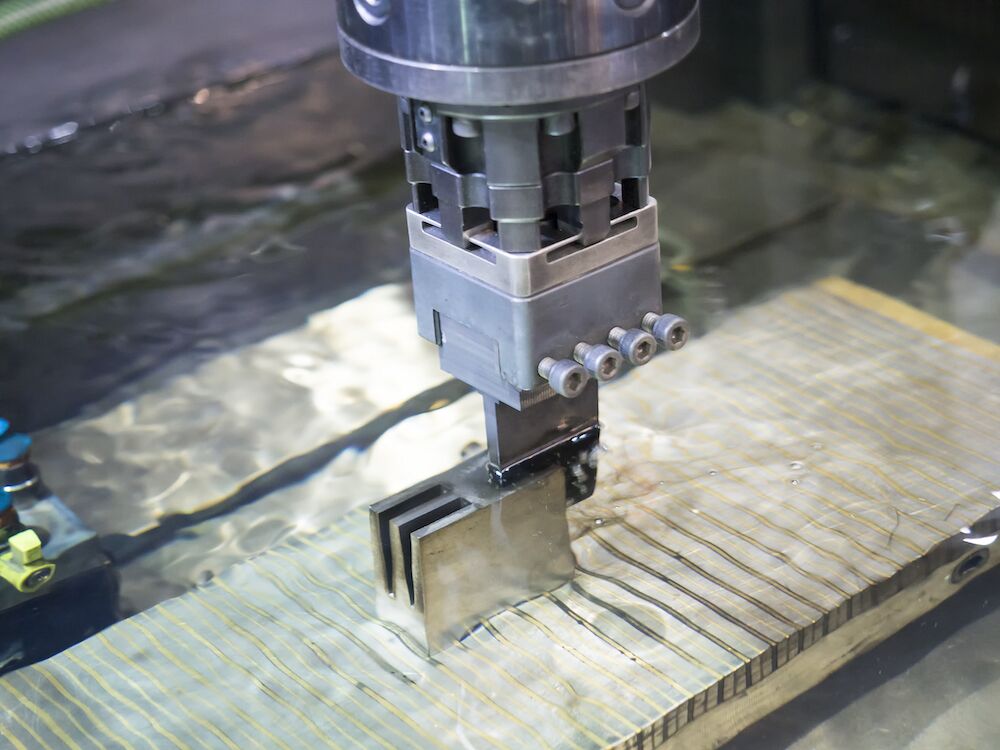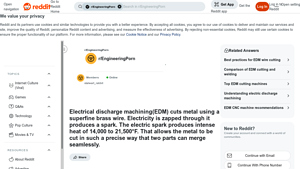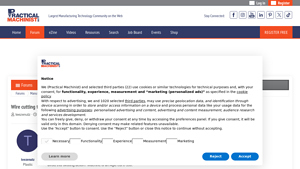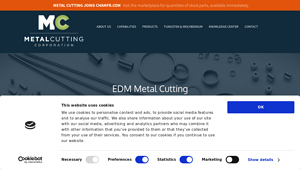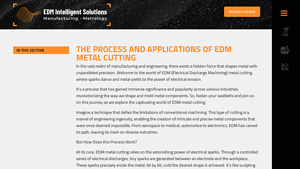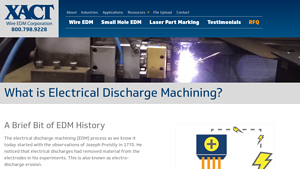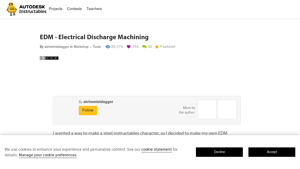Edm Metal Cutting Guide: Type, Cost, Top List…
Introduction: Navigating the Global Market for edm metal cutting
In today’s competitive landscape, sourcing reliable EDM metal cutting solutions can be a daunting challenge for international B2B buyers, particularly those operating in dynamic markets like Africa, South America, the Middle East, and Europe. As industries increasingly demand precision and efficiency, understanding the nuances of electrical discharge machining (EDM) becomes critical for businesses aiming to enhance their manufacturing capabilities. This comprehensive guide delves into the various types of EDM processes, including wire, sinker, and hole-drilling techniques, while exploring their diverse applications across multiple sectors such as aerospace, automotive, and medical device manufacturing.
Throughout this guide, we will provide actionable insights into supplier vetting practices, pricing structures, and the latest technological advancements in EDM. By equipping buyers with the knowledge to make informed decisions, this resource empowers companies to navigate the complexities of sourcing EDM solutions effectively. Whether you’re based in bustling markets like Saudi Arabia or emerging economies like Nigeria, understanding the global market landscape for EDM metal cutting is essential for optimizing production processes and achieving competitive advantage. With a focus on practical strategies and expert advice, this guide serves as a vital tool for any organization looking to leverage EDM technology to meet their manufacturing needs.
Understanding edm metal cutting Types and Variations
| Type Name | Key Distinguishing Features | Primary B2B Applications | Brief Pros & Cons for Buyers |
|---|---|---|---|
| Wire EDM | Uses a thin wire as an electrode; ideal for 2D cuts. | Tool and die manufacturing, aerospace parts | Pros: High precision, complex shapes; Cons: Limited to conductive materials. |
| Sinker EDM | Employs a 2D electrode for creating complex cavities. | Molds, automotive components | Pros: Capable of intricate designs; Cons: Slower process for larger parts. |
| EDM Hole Drilling | Focuses on drilling precise holes with minimal stress. | Aerospace, medical devices | Pros: Excellent for small, deep holes; Cons: Limited to hole-making applications. |
| Fast Hole EDM | Specialized for rapid drilling of larger holes. | Oil & gas, aerospace | Pros: Quick production time; Cons: May sacrifice some precision for speed. |
| Die-sinking EDM | Uses a shaped electrode to create detailed cavities. | Complex mold making, automotive parts | Pros: High detail and finish quality; Cons: Requires significant setup time. |
What Are the Characteristics of Wire EDM and Its Suitability for B2B Buyers?
Wire EDM is characterized by its use of a thin, electrically charged wire that cuts through conductive materials by eroding them with electrical discharges. This method is particularly suitable for producing intricate 2D shapes and is widely used in tool and die manufacturing as well as aerospace applications. B2B buyers should consider the precision required for their projects, as Wire EDM is known for its ability to achieve tight tolerances. Additionally, the choice of wire material can affect the cutting speed and finish quality, making it essential for buyers to evaluate their specific needs.
How Does Sinker EDM Stand Out in the Market?
Sinker EDM, also known as ram EDM, uses a 2D electrode that can take on complex shapes, making it ideal for creating detailed cavities in various materials. This process is particularly useful in the mold and automotive industries, where intricate designs are often required. For B2B buyers, the key consideration is the complexity of the shapes needed. While Sinker EDM offers high detail and surface finish, it may be slower than other methods for larger parts, necessitating a balance between speed and precision in production timelines.
What Is the Role of EDM Hole Drilling in Precision Applications?
EDM Hole Drilling is a specialized technique focused on creating precise holes with minimal thermal stress on the workpiece. This method is particularly advantageous in industries such as aerospace and medical devices, where precision is critical. B2B buyers should be aware that while EDM Hole Drilling excels in producing small, deep holes, it is limited to applications involving hole-making. Therefore, understanding the specific requirements of the application is crucial for buyers to maximize the benefits of this technique.
What Are the Advantages of Fast Hole EDM for B2B Buyers?
Fast Hole EDM is designed for rapid drilling of larger holes, making it a suitable option for industries like oil and gas, where speed is often a priority. The process allows for quick production times, which can significantly enhance overall efficiency. However, buyers should consider that this speed may come at the expense of some precision. For businesses needing to balance time and accuracy, understanding the trade-offs involved with Fast Hole EDM is essential for making informed purchasing decisions.
How Does Die-sinking EDM Provide Value in Complex Mold Making?
Die-sinking EDM utilizes a shaped electrode to create detailed cavities, making it invaluable in complex mold making and automotive parts production. This method is particularly effective for achieving high detail and finish quality. B2B buyers should factor in the setup time required for Die-sinking EDM, as it can be significant. However, the ability to create intricate designs often justifies the investment in this process, especially for companies focused on producing high-quality components.
Key Industrial Applications of edm metal cutting
| Industry/Sector | Specific Application of EDM Metal Cutting | Value/Benefit for the Business | Key Sourcing Considerations for this Application |
|---|---|---|---|
| Aerospace | Precision components for aircraft engines | High accuracy and reliability in critical components | Supplier certification, material traceability, and lead times |
| Automotive | Tooling for die-casting and injection molds | Enhanced production efficiency and reduced downtime | Compatibility with specific materials and tooling specifications |
| Medical Devices | Manufacturing intricate surgical instruments | Ability to produce complex geometries with precision | Compliance with medical regulations and quality standards |
| Electronics | Fabrication of connectors and circuit boards | High-quality finishes and reduced waste | Material properties and dielectric fluid compatibility |
| Oil & Gas | Custom parts for drilling equipment | Durability and performance in extreme conditions | Material strength and sourcing of conductive materials |
How is EDM Metal Cutting Applied in the Aerospace Industry?
In the aerospace sector, EDM metal cutting is essential for producing precision components such as turbine blades, fuel injectors, and other critical engine parts. These components require high accuracy and reliability to ensure optimal performance and safety. International buyers in this sector must prioritize suppliers with proper certifications and the ability to provide material traceability, as compliance with stringent industry standards is crucial. Additionally, lead times should be carefully evaluated to meet production schedules.
What Role Does EDM Metal Cutting Play in Automotive Tooling?
The automotive industry extensively uses EDM metal cutting for creating tooling for die-casting and injection molds. This technique allows manufacturers to achieve enhanced production efficiency by producing complex shapes that traditional machining methods cannot handle. Buyers in this sector should consider the compatibility of EDM services with specific materials and tooling specifications to ensure the effectiveness of the production process. Furthermore, understanding the supplier’s capacity to deliver on time is vital for minimizing downtime.
Why is EDM Metal Cutting Important in Medical Device Manufacturing?
In medical device manufacturing, EDM metal cutting is utilized to create intricate surgical instruments and components that require exceptional precision. The ability to produce complex geometries while maintaining tight tolerances is crucial for ensuring the safety and effectiveness of medical devices. International buyers must ensure their suppliers comply with medical regulations and quality standards, as well as have experience in working with biocompatible materials. This focus on compliance is essential for maintaining product integrity and patient safety.
How Does EDM Metal Cutting Benefit the Electronics Sector?
The electronics industry leverages EDM metal cutting for fabricating connectors, circuit boards, and other components that require high-quality finishes and minimal waste. This method is particularly advantageous for producing detailed features in conductive materials, which are essential for efficient electrical performance. Buyers in this sector should focus on the material properties and compatibility with dielectric fluids used in the EDM process, as these factors significantly impact the quality of the final product.
In What Ways Does EDM Metal Cutting Support Oil & Gas Applications?
In the oil and gas industry, EDM metal cutting is critical for manufacturing custom parts used in drilling equipment, such as valves and fittings. The durability and performance of these components in extreme conditions are paramount for operational success. Buyers should emphasize sourcing high-strength conductive materials and ensure that their suppliers can meet the specific requirements of harsh environments. Understanding the machining capabilities and the quality assurance processes of potential suppliers will also play a vital role in procurement decisions.
3 Common User Pain Points for ‘edm metal cutting’ & Their Solutions
Scenario 1: Difficulty in Cutting Complex Geometries
The Problem: B2B buyers often face challenges when attempting to produce intricate designs using traditional machining methods. For instance, manufacturers in the aerospace or automotive sectors may require components with complex geometries that are difficult or impossible to achieve with conventional cutting techniques. This can lead to increased production time, higher costs, and potential quality issues, causing frustration as deadlines approach.
The Solution: To address this challenge, investing in wire EDM technology can be a game changer. Wire EDM is adept at cutting complex shapes with high precision, making it suitable for intricate designs. When sourcing an EDM machine, ensure you select one with advanced CNC capabilities that allow for multi-axis cutting. Collaborate closely with your EDM supplier to understand the machine’s specifications and capabilities, including the types of wire that can be used, such as brass or zinc-coated wire. Additionally, consider working with an experienced EDM technician who can optimize the settings for your specific project, ensuring a smooth and efficient cutting process.
Scenario 2: Material Limitations and Compatibility Issues
The Problem: Many buyers encounter frustration when their chosen materials are incompatible with their current machining processes. For instance, if a company specializes in manufacturing parts from high-strength materials like titanium or hardened steels, they may discover that traditional cutting methods can lead to excessive wear on tools or produce unwanted thermal distortion, ultimately affecting the quality and performance of the final product.
The Solution: To overcome material limitations, it is crucial to leverage the advantages of EDM technology. EDM is capable of machining a wide range of conductive materials, including tough alloys that resist conventional cutting methods. When selecting an EDM process, ensure that your machine is equipped to handle the specific material requirements of your projects. This includes utilizing the appropriate dielectric fluids, like deionized water, to effectively manage heat and improve cutting quality. Additionally, consider consulting with material experts or your EDM supplier to identify the best wire and settings that will enhance performance and reduce tool wear when working with challenging materials.
Scenario 3: Cost Management and Production Efficiency
The Problem: Cost management is a significant concern for B2B buyers, particularly in competitive markets. Companies often struggle with high operational costs due to inefficient machining processes that lead to waste, rework, and long lead times. This inefficiency can diminish profit margins and hinder the ability to meet customer demands promptly, which is critical in industries like electronics or medical devices.
The Solution: To improve cost management and production efficiency, integrating EDM technology can provide substantial benefits. By automating the EDM process with sophisticated CNC controls, manufacturers can achieve greater precision and reduce material waste. Start by conducting a cost-benefit analysis to determine the potential savings associated with switching to EDM for specific applications. Furthermore, ensure that your team is trained in best practices for EDM operation, including regular maintenance of the machines and proper setup of the cutting parameters. This will help minimize downtime and optimize production runs, ultimately leading to lower costs and improved profitability. Regularly review and analyze production data to identify areas for further efficiency improvements, ensuring that your processes remain competitive.
Strategic Material Selection Guide for edm metal cutting
What Are the Key Properties of Brass in EDM Metal Cutting?
Brass is a popular choice for EDM metal cutting due to its excellent electrical conductivity and good machinability. It typically exhibits a tensile strength of around 300-600 MPa and a melting point of approximately 900°C. Brass is also resistant to corrosion, which enhances its durability in various applications. However, its softness can lead to a gummy buildup during machining, which may affect the quality of the cut.
Pros & Cons of Brass in EDM Metal Cutting
The primary advantage of using brass is its high conductivity, allowing for efficient energy transfer during the EDM process. Additionally, it is relatively cost-effective compared to other conductive materials. However, its softness can be a drawback, requiring slower cutting speeds to avoid issues. Brass may also not be suitable for applications requiring high strength or wear resistance.
Impact on Application
Brass is commonly used in the manufacturing of electrical components, connectors, and decorative items due to its aesthetic appeal. However, its application may be limited in high-stress environments where stronger materials are required.
How Does Titanium Perform in EDM Metal Cutting?
Titanium is known for its high strength-to-weight ratio and excellent corrosion resistance, making it a preferred material in aerospace and medical applications. It has a tensile strength ranging from 300 to 900 MPa and a melting point of about 1660°C. Its unique properties allow it to withstand extreme temperatures and pressures without deforming.
Pros & Cons of Titanium in EDM Metal Cutting
The key advantage of titanium is its exceptional durability and ability to maintain structural integrity under high stress. However, the cost of titanium is relatively high, making it a significant investment for manufacturers. Additionally, its machining can be complex due to its tendency to produce long chips, which may require specialized handling.
Impact on Application
Titanium is particularly suited for applications in the aerospace and medical sectors, where performance and reliability are paramount. Its compatibility with various media, including corrosive environments, makes it a versatile choice.
What Are the Benefits of Using Steel in EDM Metal Cutting?
Steel is one of the most commonly used materials in EDM cutting, offering a balance of strength, durability, and affordability. It typically has a tensile strength of 400-800 MPa and a melting point of around 1370°C. Steel’s versatility allows it to be used in a wide range of applications, from automotive parts to industrial machinery.
Pros & Cons of Steel in EDM Metal Cutting
The primary advantage of steel is its strength and durability, making it suitable for high-load applications. Its cost is generally moderate, providing a good balance between performance and expense. However, steel can generate significant heat during machining, which may lead to warping or dimensional inaccuracies if not managed properly.
Impact on Application
Steel is widely used in the manufacturing of tools, dies, and structural components. Its ability to withstand high pressures and temperatures makes it ideal for heavy-duty applications, although care must be taken to manage heat during the cutting process.
Why Is Graphite an Effective Material for EDM Metal Cutting?
Graphite is increasingly being utilized in EDM due to its unique properties, including high thermal conductivity and excellent machinability. It has a melting point of around 3650°C and can withstand high temperatures without degrading. Graphite also offers low friction, which can enhance the machining process.
Pros & Cons of Graphite in EDM Metal Cutting
The main advantage of graphite is its ability to produce intricate shapes with high precision. It is also relatively cost-effective compared to metals. However, graphite can be brittle, leading to potential breakage during machining. Additionally, its dust can pose health risks if proper safety measures are not followed.
Impact on Application
Graphite is commonly used for making electrodes in EDM processes, particularly for complex shapes and fine details. Its compatibility with various materials allows for versatility in applications ranging from mold making to aerospace components.
Summary Table of Material Selection for EDM Metal Cutting
| Material | Typical Use Case for edm metal cutting | Key Advantage | Key Disadvantage/Limitation | Relative Cost (Low/Med/High) |
|---|---|---|---|---|
| Brass | Electrical components, connectors | High conductivity | Softness leads to buildup | Low |
| Titanium | Aerospace, medical applications | Exceptional durability | High cost | High |
| Steel | Tools, dies, structural components | Strong and durable | Heat generation issues | Med |
| Graphite | Electrodes for intricate shapes | High precision and low friction | Brittle and health risks | Med |
In-depth Look: Manufacturing Processes and Quality Assurance for edm metal cutting
What Are the Main Stages of the EDM Metal Cutting Manufacturing Process?
The manufacturing process for EDM (Electrical Discharge Machining) metal cutting involves several critical stages, ensuring precision and quality in the final product. Understanding these stages can help B2B buyers make informed decisions when selecting suppliers.
1. Material Preparation: How Is the Workpiece Selected and Prepared?
The initial stage of the EDM process begins with material selection. Typically, materials must be electrically conductive, such as steel, aluminum, brass, copper, and titanium. Once the material is chosen, it undergoes a preparatory phase where it is cut to size and cleaned to remove any contaminants that could interfere with the machining process. This might involve using ultrasonic cleaners or solvents to ensure the material is free from grease, dirt, or oxidation.
2. Forming: What Techniques Are Used for EDM Cutting?
The actual EDM cutting process involves submerging the workpiece in a dielectric fluid, which is essential for the electrical discharge to occur. The wire electrode, typically made from brass or zinc-coated materials, is fed through the material to create precise cuts. The wire’s movement is controlled by a CNC system, which dictates the cutting path based on the programmed design. This stage is characterized by the ability to create complex geometries and tight tolerances that are often unattainable through traditional machining methods.
3. Assembly: How Are Components Integrated Post-Cutting?
Once the EDM cutting is complete, the machined parts may require additional assembly, especially if they are components of a larger assembly. This could involve fitting together various machined parts, welding, or attaching additional components. The assembly stage may also include further machining processes to refine the fit and finish of the components.
4. Finishing: What Processes Ensure Quality and Precision?
Finishing processes follow assembly to enhance the surface quality of the machined components. Techniques such as grinding, polishing, or surface hardening may be employed to achieve desired surface finishes and tolerances. This stage is critical, particularly in industries such as aerospace and medical devices, where precision is paramount.
How Is Quality Assurance Implemented in EDM Metal Cutting?
Quality assurance (QA) is a fundamental aspect of the EDM metal cutting process, ensuring that products meet international and industry-specific standards. For B2B buyers, understanding these QA measures can help in selecting reliable suppliers.
Relevant International Standards: What Certifications Should Buyers Look For?
The most recognized international standard for quality management systems is ISO 9001. Compliance with this standard indicates that the supplier has established a quality management system capable of ensuring consistent product quality. Additionally, industry-specific certifications, such as CE marking for products sold in Europe or API standards for oil and gas equipment, can further validate a supplier’s commitment to quality.
What Are the Key Quality Control Checkpoints in the EDM Process?
Quality control (QC) involves several checkpoints throughout the manufacturing process:
-
Incoming Quality Control (IQC): This is the first checkpoint, where raw materials are inspected upon receipt. Verification of material certifications, dimensions, and surface conditions are critical at this stage to prevent defects from the outset.
-
In-Process Quality Control (IPQC): During the EDM process, regular checks are conducted to monitor parameters such as voltage, current, and cutting speed. These parameters are critical in ensuring that the machining process remains within specified limits, thus maintaining the integrity of the workpiece.
-
Final Quality Control (FQC): After machining and finishing, the final product undergoes a comprehensive inspection. This can include dimensional checks using CMM (Coordinate Measuring Machines), surface finish evaluations, and functional testing to ensure the part meets all specifications.
What Testing Methods Are Commonly Used in EDM Quality Assurance?
Several testing methods are commonly employed to verify the quality of EDM machined components:
-
Dimensional Inspection: Utilizing tools like calipers and micrometers, dimensional inspections ensure that the parts meet the exact specifications outlined in the design documentation.
-
Surface Roughness Measurement: Instruments like surface roughness testers are used to evaluate the finish quality of the machined surfaces, which is critical for parts requiring tight tolerances.
-
Non-Destructive Testing (NDT): Techniques such as ultrasonic testing or dye penetrant testing may be employed to detect internal flaws or cracks that could compromise the part’s integrity.
How Can B2B Buyers Verify Supplier Quality Control Processes?
For international B2B buyers, verifying the quality control processes of potential suppliers is crucial. Here are some actionable steps:
-
Conduct Audits: Schedule audits of the supplier’s facility to assess their manufacturing processes, quality control measures, and adherence to industry standards.
-
Request Quality Reports: Ask for detailed QC reports that outline inspection results, compliance with standards, and any corrective actions taken for non-conformities.
-
Engage Third-Party Inspectors: Consider hiring independent inspection agencies to evaluate the supplier’s processes and products. This adds an extra layer of assurance regarding the quality of the products being procured.
What Are the Quality Control Nuances for International B2B Buyers?
Navigating the complexities of international procurement requires an understanding of various quality control nuances:
-
Cultural Differences: Be aware of cultural attitudes towards quality and compliance in different regions. Some countries may have varying standards for quality assurance, which could impact product consistency.
-
Regulatory Compliance: Ensure that suppliers comply with local regulations and international standards that pertain to your industry. This is particularly important in regions like Africa and the Middle East, where regulations may differ significantly from those in Europe or South America.
-
Supply Chain Transparency: Request transparency in the supply chain, including sourcing of materials and subcontractor involvement. This is crucial for understanding potential risks associated with quality.
By taking these steps, B2B buyers can significantly enhance their procurement strategies, ensuring that they partner with suppliers who prioritize quality and compliance in their EDM metal cutting processes.
Practical Sourcing Guide: A Step-by-Step Checklist for ‘edm metal cutting’
In the competitive landscape of EDM (Electrical Discharge Machining) metal cutting, sourcing the right equipment and services is crucial for achieving precision and efficiency. This guide provides a structured checklist for B2B buyers to ensure they make informed decisions when procuring EDM solutions.
Step 1: Define Your Technical Specifications
Clearly outline the specifications of your machining needs, including material types, tolerances, and desired surface finishes. This step is vital to communicate effectively with potential suppliers and to ensure they can meet your project requirements. Consider aspects such as the size of the components and complexity of the designs you intend to produce.
Step 2: Research and Identify Potential Suppliers
Conduct thorough research to identify reputable EDM suppliers. Utilize industry directories, trade shows, and professional networks to compile a list of potential partners. Pay attention to suppliers with a strong track record in your specific industry, as their experience can greatly influence the quality and reliability of the service provided.
Step 3: Evaluate Supplier Capabilities
Before committing, assess the technical capabilities of each supplier. Look for details such as the types of EDM machines they operate (e.g., wire EDM, sinker EDM), their operational capacity, and the range of materials they can process. A supplier with advanced machinery and a versatile skill set will be better equipped to handle complex projects efficiently.
Step 4: Verify Supplier Certifications and Quality Standards
Ensure that the suppliers you consider adhere to relevant industry standards and certifications. This includes ISO certifications and compliance with local regulations. Quality assurance is crucial in EDM processes, as it directly impacts the precision and durability of the finished products.
Step 5: Request Case Studies and References
Ask potential suppliers for case studies and references from previous clients, particularly those in similar sectors or projects. This will provide insights into their performance, reliability, and customer satisfaction levels. A supplier with a strong portfolio of successful projects can give you confidence in their capabilities.
Step 6: Discuss Lead Times and Delivery Logistics
Engage with suppliers to understand their lead times and delivery capabilities. Timely delivery is critical in manufacturing; delays can disrupt your production schedule. Clarify the logistics involved, including shipping options and any potential customs considerations for international suppliers.
Step 7: Negotiate Pricing and Terms of Service
Once you have shortlisted suppliers, initiate discussions around pricing and terms of service. Ensure that you understand the total cost of ownership, including any additional fees for setup, tooling, or maintenance. Aim for a transparent agreement that outlines expectations and responsibilities for both parties.
By following this checklist, B2B buyers can streamline their sourcing process for EDM metal cutting solutions, ensuring they partner with suppliers who can meet their technical needs and support their business objectives effectively.
Comprehensive Cost and Pricing Analysis for edm metal cutting Sourcing
What Are the Key Cost Components in EDM Metal Cutting?
When sourcing EDM metal cutting services, understanding the cost structure is crucial for effective budget management. The primary cost components include:
-
Materials: The choice of materials plays a significant role in determining overall costs. Commonly cut materials include aluminum, steel, titanium, and brass. The price of these materials can fluctuate based on market demand and availability. Additionally, the type of wire used in the EDM process—such as brass or zinc-coated wire—also influences material costs.
-
Labor: Skilled labor is essential in EDM machining. The cost associated with labor varies by region and the complexity of the project. Higher labor costs may be encountered in areas with stringent labor regulations or where specialized skills are required.
-
Manufacturing Overhead: This includes costs related to facility maintenance, utilities, and equipment depreciation. Efficient operations can help mitigate overhead costs, but these expenses must be factored into pricing.
-
Tooling: Tooling costs encompass the initial investment in EDM machines and ongoing maintenance. The sophistication of the equipment can also affect pricing, with advanced machines capable of higher precision and speed commanding a premium.
-
Quality Control (QC): Rigorous QC processes are necessary to ensure that parts meet specifications and industry standards. Investing in quality assurance can increase upfront costs but can lead to significant savings in the long run by reducing defects and rework.
-
Logistics: Shipping and handling costs can vary significantly based on the geographical location of suppliers and customers. International shipping, customs duties, and packaging considerations all contribute to the logistics costs.
-
Margin: Suppliers often build a profit margin into their pricing, which can vary based on market competition and their operational efficiency.
What Influences Pricing in EDM Metal Cutting?
Several factors can influence the pricing of EDM metal cutting services:
-
Volume/MOQ: Bulk orders often come with discounted pricing. Understanding the minimum order quantity (MOQ) and negotiating for larger volumes can lead to significant cost savings.
-
Specifications and Customization: Highly customized parts or those requiring complex shapes may incur additional costs. Clear communication of specifications can help in receiving accurate quotes.
-
Materials: The choice of materials not only affects initial costs but can also impact the machining process. For instance, harder materials may require more machining time, increasing labor costs.
-
Quality and Certifications: Parts that require specific certifications or higher quality standards typically come at a premium. Buyers should clarify these requirements upfront to avoid unexpected costs.
-
Supplier Factors: Supplier reputation, experience, and location can affect pricing. Suppliers with a strong track record may charge more for their expertise.
-
Incoterms: Understanding the Incoterms governing shipping can impact total costs. Buyers should be aware of who bears responsibility for shipping costs, insurance, and customs duties.
How Can Buyers Optimize Costs in EDM Metal Cutting?
To ensure cost efficiency in EDM metal cutting sourcing, buyers can adopt several strategies:
-
Negotiate Wisely: Leverage volume discounts and establish long-term relationships with suppliers. This can lead to more favorable pricing structures.
-
Consider Total Cost of Ownership (TCO): Evaluate not just the upfront costs but also the long-term implications of sourcing decisions. Cheaper parts may lead to higher maintenance or replacement costs.
-
Understand Pricing Nuances for International Sourcing: International buyers should be aware of currency fluctuations, import tariffs, and local regulations that could impact costs. Establishing strong communication with suppliers can help navigate these complexities.
-
Request Detailed Quotes: Suppliers should provide itemized quotes that break down the costs associated with materials, labor, and overhead. This transparency allows for better comparison and negotiation.
Disclaimer
Prices mentioned in this analysis are indicative and can vary widely based on market conditions, supplier capabilities, and project requirements. Always obtain multiple quotes and conduct due diligence when sourcing EDM metal cutting services.
Alternatives Analysis: Comparing edm metal cutting With Other Solutions
Understanding Alternatives to EDM Metal Cutting
In the realm of precision machining, Electrical Discharge Machining (EDM) is a well-established method, especially for hard and conductive materials. However, several alternative cutting methods also exist, each with unique advantages and limitations. B2B buyers must consider these alternatives based on specific project requirements, including material type, complexity, and cost-effectiveness.
Comparison Table
| Comparison Aspect | EDM Metal Cutting | Laser Cutting | Waterjet Cutting |
|---|---|---|---|
| Performance | High precision, minimal distortion | High speed, good precision | Versatile, good for thick materials |
| Cost | High initial investment, variable operating costs | Moderate initial investment, low operational cost | Moderate to high investment, depending on setup |
| Ease of Implementation | Requires skilled operators and setup | Generally user-friendly, less training needed | Can be complex, requires proper setup |
| Maintenance | Moderate, requires regular checks on electrodes | Low, mainly lens replacement | High, requires regular maintenance of pumps and nozzles |
| Best Use Case | Complex shapes in hard materials | Thin metals and non-metals | Thick materials, soft materials, and intricate designs |
Detailed Breakdown of Alternatives
Laser Cutting
Laser cutting employs focused beams of light to melt or vaporize material, making it suitable for a range of materials, including metals, plastics, and ceramics. Its speed and accuracy make it an excellent choice for high-volume production, especially when working with thinner materials. However, laser cutting can struggle with reflective metals and may not achieve the same depth of cut as EDM. Additionally, while initial costs are moderate, operational costs can be low due to the efficiency of the process.
Waterjet Cutting
Waterjet cutting uses a high-pressure jet of water mixed with abrasive particles to cut through materials. This method is particularly effective for thick materials and can handle a wide variety of substances, including metals, glass, and composites. One of its significant advantages is that it does not produce heat-affected zones, making it ideal for materials sensitive to thermal distortion. However, the complexity of setup and the need for regular maintenance on pumps and nozzles can increase operational downtime and costs.
Conclusion: How to Choose the Right Solution for Your Needs
Selecting the right cutting method hinges on a thorough understanding of your specific requirements. For projects demanding intricate designs in hard materials, EDM metal cutting remains a strong contender due to its unmatched precision. However, if speed and versatility with various materials are priorities, alternatives like laser or waterjet cutting may be more suitable. B2B buyers should assess their operational capabilities, budget constraints, and the technical expertise available to ensure they choose the most effective solution for their machining needs.
Essential Technical Properties and Trade Terminology for edm metal cutting
What Are the Key Technical Properties in EDM Metal Cutting?
When engaging in EDM metal cutting, understanding specific technical properties is crucial for ensuring that the machining process meets industry standards and client specifications. Here are some essential properties:
1. Material Conductivity
Conductivity is a fundamental property in EDM processes, as only electrically conductive materials can be machined effectively. Metals such as aluminum, brass, copper, and titanium are commonly used. For B2B buyers, knowing the conductivity of materials ensures that the selected parts can be machined with precision and efficiency, minimizing production delays.
2. Tolerance Levels
Tolerance refers to the allowable variation in a manufactured part’s dimensions. In EDM machining, tight tolerances (often within ±0.002 inches) can be achieved, making it suitable for high-precision applications like aerospace and medical devices. For buyers, understanding tolerance requirements is vital to ensure that components fit correctly in assemblies, reducing the risk of costly rework.
3. Surface Finish Quality
The surface finish of a machined part directly impacts its functionality and aesthetic appeal. EDM processes typically produce smooth surfaces with finishes as fine as Ra 0.2 micrometers. For B2B buyers, specifying surface finish requirements can enhance product performance and reduce the need for additional processing steps.
4. Wire Diameter
The diameter of the wire used in wire EDM affects the width of the cut and the complexity of the shapes that can be produced. Common wire diameters range from 0.05 mm to 0.25 mm. Buyers should consider the wire diameter in relation to the design specifications of their components to ensure optimal machining results.
5. Dielectric Fluid Type
The choice of dielectric fluid impacts the machining process by cooling the workpiece and removing eroded particles. Deionized water is commonly used due to its effectiveness in maintaining a stable cutting environment. Understanding the implications of dielectric fluid selection helps buyers optimize machining efficiency and part quality.
What Are Common Trade Terms in EDM Metal Cutting?
Familiarity with industry jargon is essential for effective communication and negotiation in the EDM metal cutting market. Here are some key terms:
1. OEM (Original Equipment Manufacturer)
An OEM is a company that produces parts or equipment that may be marketed by another manufacturer. Understanding the role of OEMs is crucial for buyers when sourcing components, as it can impact quality, pricing, and lead times.
2. MOQ (Minimum Order Quantity)
MOQ refers to the smallest quantity of a product that a supplier is willing to sell. For B2B buyers, being aware of MOQs is important for budgeting and planning inventory, especially when dealing with specialized EDM components that may have higher production costs.
3. RFQ (Request for Quotation)
An RFQ is a document sent to suppliers to solicit price quotes for specific products or services. For buyers, issuing an RFQ is a strategic step to ensure competitive pricing and to clarify specifications, enabling better decision-making.
4. Incoterms (International Commercial Terms)
Incoterms are a set of predefined international trade terms that clarify the responsibilities of buyers and sellers in shipping and delivery. Understanding these terms helps B2B buyers manage logistics and mitigate risks associated with international transactions.
5. Lead Time
Lead time is the period from the initiation of an order to the delivery of the product. In the context of EDM metal cutting, understanding lead times is essential for project scheduling and ensuring timely delivery of components to meet production deadlines.
6. Tapping and Threading
These are machining processes used to create internal or external threads on components. Familiarity with tapping and threading terminology is important for buyers looking to specify parts that require precise threading for assembly.
By grasping these technical properties and trade terms, B2B buyers can make informed decisions, enhancing their procurement processes and ensuring successful collaboration with suppliers in the EDM metal cutting industry.
Navigating Market Dynamics and Sourcing Trends in the edm metal cutting Sector
What Are the Key Trends Driving the EDM Metal Cutting Market?
The EDM metal cutting sector is experiencing significant growth, driven by global demand for precision manufacturing across various industries, including aerospace, automotive, and medical devices. International B2B buyers, particularly from regions such as Africa, South America, the Middle East, and Europe, are increasingly seeking advanced machining solutions that offer higher accuracy and reduced waste. The rise of Industry 4.0 technologies, such as IoT-enabled machines and AI-driven analytics, is reshaping sourcing strategies, enabling companies to optimize production processes and minimize operational downtime.
Emerging trends include the adoption of hybrid manufacturing techniques that combine traditional machining with additive manufacturing. This integration allows for the creation of complex geometries that were previously unattainable with conventional methods. Moreover, there is a growing emphasis on automation within EDM processes, which enhances productivity and ensures consistent quality. B2B buyers are also focusing on suppliers that offer comprehensive service packages, including machine maintenance and operational training, to maximize their investment in EDM technologies.
How Is Sustainability and Ethical Sourcing Impacting B2B Decisions in EDM Metal Cutting?
Sustainability is becoming a critical consideration for B2B buyers in the EDM metal cutting sector. The environmental impact of manufacturing processes, including energy consumption and waste generation, is under scrutiny. Companies are increasingly prioritizing suppliers that adopt sustainable practices, such as utilizing eco-friendly dielectric fluids and optimizing energy efficiency in their machinery.
Furthermore, ethical sourcing is gaining traction, with a focus on transparency throughout the supply chain. Buyers are looking for suppliers who can demonstrate adherence to environmental and social governance (ESG) criteria. Certifications such as ISO 14001 for environmental management systems and adherence to responsible sourcing initiatives can be significant differentiators in the marketplace. By aligning with suppliers committed to sustainability, companies not only enhance their brand reputation but also meet the growing demand from consumers for environmentally responsible products.
What Has Been the Evolution of EDM Metal Cutting Technology?
EDM technology has evolved significantly since its inception in the mid-20th century. Initially developed for precision hole drilling, the technique has expanded to include various forms, such as wire EDM and sinker EDM, each designed to address specific manufacturing challenges. The introduction of CNC technology has further refined EDM processes, allowing for more complex shapes and tighter tolerances.
Over the years, advancements in materials science have led to the development of specialized wires and electrodes that enhance the efficiency and effectiveness of EDM operations. Today, the integration of digital technologies, such as real-time monitoring and predictive maintenance, is paving the way for the next generation of EDM machining solutions. This evolution not only improves the precision and speed of manufacturing but also aligns with the broader trends of automation and smart manufacturing, providing international B2B buyers with innovative solutions that cater to the demands of modern industry.
Frequently Asked Questions (FAQs) for B2B Buyers of edm metal cutting
-
How do I choose the right EDM supplier for my business needs?
Selecting the right EDM supplier involves several factors. Start by assessing their experience in the industry and the range of materials they can work with. Check for certifications and quality assurance processes, as these indicate their commitment to high standards. It’s also beneficial to request samples of previous work to evaluate their capabilities. Lastly, consider their communication responsiveness and willingness to customize solutions, as these traits can enhance collaboration. -
What is the typical lead time for EDM metal cutting services?
Lead times for EDM metal cutting services can vary based on several factors, including project complexity, material availability, and the supplier’s workload. Generally, you can expect lead times to range from a few days to several weeks. For urgent projects, it’s advisable to discuss expedited options with your supplier upfront. Always clarify timelines in your contract to avoid misunderstandings. -
What materials are best suited for EDM metal cutting?
EDM metal cutting is highly effective for various electrically conductive materials, including aluminum, brass, copper, titanium, and tool steels. Each material presents unique challenges; for instance, aluminum may gum up, while titanium requires careful heat management. When selecting a material, consider not only its conductivity but also its hardness and machining characteristics to ensure optimal results. -
How can I ensure quality assurance in EDM machining?
To ensure quality assurance in EDM machining, establish clear specifications and tolerances in your project documentation. Work with suppliers who implement rigorous QA processes, including regular inspections and testing of finished parts. Request certificates of compliance and consider third-party inspections for critical components. Building a relationship with a reliable supplier who prioritizes quality will further safeguard your interests. -
What are the minimum order quantities (MOQs) for EDM services?
Minimum order quantities (MOQs) for EDM services can differ significantly among suppliers. Some may accommodate low-volume orders, while others may set higher MOQs to justify production costs. Discuss your specific needs with potential suppliers to find a partner who can meet your volume requirements without compromising on quality. Flexibility in MOQs can often be negotiated, especially for long-term partnerships. -
What payment terms should I consider when sourcing EDM services internationally?
Payment terms can vary widely in international transactions, so it’s crucial to negotiate terms that protect both parties. Common arrangements include upfront deposits, milestone payments, or payment upon delivery. Consider using secure payment methods like letters of credit or escrow services for larger transactions. Always clarify payment terms in the contract to avoid disputes later. -
How do logistics and shipping impact EDM metal cutting orders?
Logistics and shipping play a critical role in the timeliness and cost-effectiveness of EDM metal cutting orders. Consider the proximity of your supplier to your location to minimize shipping times and costs. Discuss shipping options, including freight forwarding and customs clearance, to ensure smooth delivery. It’s also wise to factor in potential delays due to international regulations, especially when sourcing from different continents. -
Can EDM machining be customized for my specific applications?
Yes, EDM machining can be tailored to meet specific application requirements. Many suppliers offer customization options, including adjustments in cutting speeds, wire types, and dielectric fluids based on your project needs. Engage in detailed discussions with your supplier about your design specifications and desired outcomes to leverage their expertise in providing a customized solution that aligns with your operational goals.
Important Disclaimer & Terms of Use
⚠️ Important Disclaimer
The information provided in this guide, including content regarding manufacturers, technical specifications, and market analysis, is for informational and educational purposes only. It does not constitute professional procurement advice, financial advice, or legal advice.
While we have made every effort to ensure the accuracy and timeliness of the information, we are not responsible for any errors, omissions, or outdated information. Market conditions, company details, and technical standards are subject to change.
B2B buyers must conduct their own independent and thorough due diligence before making any purchasing decisions. This includes contacting suppliers directly, verifying certifications, requesting samples, and seeking professional consultation. The risk of relying on any information in this guide is borne solely by the reader.
Top 7 Edm Metal Cutting Manufacturers & Suppliers List
1. Reddit – Electrical Discharge Machining (EDM)
Domain: reddit.com
Registered: 2005 (20 years)
Introduction: Electrical discharge machining (EDM) cuts metal using a superfine brass wire. The process involves electricity creating a spark that generates intense heat ranging from 14,000 to 21,500°F, allowing for precise metal cutting that enables two parts to merge seamlessly.
2. Agie – Cut E-350 EDM Machine
Domain: practicalmachinist.com
Registered: 2000 (25 years)
Introduction: Product: Agie cut e-350 EDM Machine
Material: Cold rolled steel, 2.5mm thickness
Application: Profile grinder templates for the woodworking industry
Challenges: Twisting and warping of material during cutting, wire breaks, prolonged negative erosion error
Recommendations: Use more stable materials (e.g., annealed/normalized steel, 4140 pre-hard alloy), avoid cutting near edges, clamp securely, use…
3. Metal Cutting – EDM Cut Off Solutions
Domain: metalcutting.com
Registered: 1996 (29 years)
Introduction: EDM Metal Cutting provides burr-free, highly precise 2-axis EDM cut off for small diameter, solid metal parts such as pins and probes. The process is capable of cutting non-composite and non-coated materials including copper, molybdenum, and tungsten. It delivers consistent lengths without deformation or distortion, with a kerf width of 0.004″ to 0.012″ (0.1 to 0.3 mm) and diameters from a few tho…
4. EDM Dept – Precision Metal Cutting Services
Domain: edmdept.com
Registered: 1997 (28 years)
Introduction: EDM Metal Cutting Services include Wire EDM Machining, Fine Wire EDM, Sinker EDM Machining, EDM Hole Drilling, Fine Hole EDM Drilling, Micro Milling, Laser Ablation, Precision Grinding, Micro Manufacturing, and Contract Manufacturing. Applications span across various industries such as Aerospace & Defense, Automotive, Electronics, Energy, Medical & Pharmaceutical, and Scientific Component Manufact…
5. XactedM – Wire EDM Solutions
Domain: xactedm.com
Registered: 1997 (28 years)
Introduction: Wire EDM, also known as wire-cut EDM, wire cutting, EDM wire cutting, and wire erosion, utilizes a thin metallic wire to cut or shape conductive materials. The wire diameter typically ranges from 0.004″ to 0.012″ (0.10mm to 0.30mm). The process involves no direct contact between the wire and the workpiece, preventing distortion. The wire is charged to a specific voltage, creating sparks that melt …
6. GF Machining Solutions – Wire-Cutting EDM Machines
Domain: gfms.com
Registered: 1999 (26 years)
Introduction: Wire-cutting EDM machines by GF Machining Solutions utilize an electrical spark between a conductive wire and a workpiece to remove material. Key features include: 1. Intelligent Power Generator (IPG) – a fully digital generator for high performance and low power consumption. 2. Turbo Tech – a cutting technology balancing speed and accuracy. 3. ISPS (Intelligent Spark Protection System) – adapts c…
7. Instructables – EDM Machine
Domain: instructables.com
Registered: 2005 (20 years)
Introduction: EDM – Electrical Discharge Machining is a method of cutting metal using electric sparks, similar to a plasma cutter but on a smaller scale and under water. The process is commonly used in the manufacturing of injection molds. The machine can be built using simple hand tools and supplies from a local hardware store. Key components include a linear slide for precise tool positioning, a tool that is …
Strategic Sourcing Conclusion and Outlook for edm metal cutting
The landscape of EDM metal cutting continues to evolve, offering international B2B buyers significant opportunities for precision manufacturing. By understanding the diverse EDM methods—especially wire EDM, sinker EDM, and hole-drilling EDM—businesses can select the most effective techniques for their specific applications. Key considerations such as the choice of materials, electrode types, and dielectric fluids directly impact the quality and efficiency of the cutting process.
Strategic sourcing plays a pivotal role in optimizing costs and enhancing supply chain resilience. Buyers should focus on establishing strong partnerships with reliable EDM service providers who understand regional market dynamics, particularly in Africa, South America, the Middle East, and Europe. This collaboration not only ensures access to advanced technologies but also fosters innovation tailored to local manufacturing needs.
Looking ahead, the future of EDM metal cutting is bright, driven by technological advancements and an increasing demand for high-precision components. International buyers are encouraged to explore new suppliers, invest in cutting-edge EDM technologies, and leverage strategic sourcing to enhance their competitive edge. Embrace these opportunities to transform your manufacturing processes and drive sustainable growth.
